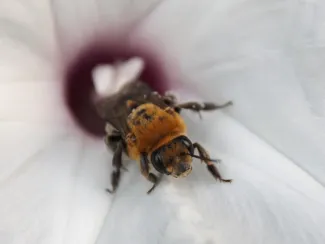Researchers with the Oklahoma Natural Heritage Inventory recently documented a rare species of bee, the morning glory longhorn, while conducting a survey at Cookson Wildlife Management Area. This is the first time the species has been detected in the state; though it is generally thought to range east of the Great Plains, the bee was also documented in eastern Colorado in 2013.

The rare morning glory longhorn bee was first detected in Oklahoma in July 2022 by surveyors with the Oklahoma Natural Heritage Inventory. This female bee was photographed in Ohio.
“The bee is on the larger side, about the size of the first digit of your pinky finger,” said Mary Powley, research technician with the Oklahoma Natural Heritage Inventory. “The defining feature for the species is a distinctly shaped structure found just above the mandibles, but in general, this is a larger, more robust, and hairier bee species.”
Light orange to reddish-orange hairs cover the bee’s thorax, or middle body segment, while whitish hairs cover the bee’s abdomen, or last body segment, giving the abdomen a frosted appearance. Males of this species have long antennae, a trait common among longhorn bees, but those antennae are unusually thin when compared to other North American longhorn bee species.
Powley documented the bee in July while examining a patch of bigroot morning glory growing along a Cookson WMA roadside. Her work was part of a larger effort by the Oklahoma Natural Heritage Inventory to document the state’s bee community.
“Part of the expedition’s goal was to focus surveys around bigroot morning glory as the plant hosts several specialist bees, or bees that provide their larvae with pollen from a strict set of plants. The association of the longhorn bee to this plant is so strong that the bee’s scientific and common names are derived from the host plant.
“Since the bee is known in the literature to be active around dawn and into the very early morning, I got to Cookson WMA and started the survey by about 7 a.m. I established myself along a good patch of bigroot morning glory, walked along that patch, and caught anything I could.”
After surveying for an hour and a half without finding the specialized longhorn bee, Powley was preparing to relocate to another survey area when she saw a pale-colored bee fly into a morning glory flower. Seconds after she captured and secured the bee, a male morning glory longhorn, another pale bee flew straight into the same flower. The second bee, a female of the species, was also captured, indicating an established population may occur at Cookson WMA.
“I’m a naturalist first and foremost,” Powley said. “Having spent over a half a decade focusing on bees, it was an exciting moment to not only see a species I have never seen before, but to also get to contribute such a find to the continuously growing state list. I was thrilled.”
Building the List Bee by Bee
“Most U.S. states do not yet have officially published lists of bees or other pollinators,” said James Hung, biologist with the Oklahoma Natural Heritage Inventory and Powley’s supervisor. “We’re starting to get to the point where insect and pollinator conservation is deemed enough of a priority for there to be support for developing these types of lists.”
In fact, the Oklahoma Natural Heritage Inventory team has received funding from the Wildlife Department to assess the conservation status of Oklahoma’s 10 or so bumble bee species, and from the U.S. Fish and Wildlife Service to document pollinators inhabiting the nine National Wildlife Refuges in the state. Both projects are slated to begin in 2023.
In the meantime, Hung launched a statewide survey of native bees and the host plants on which they rely. He has also collaborated with other scientists to gather an initial list of native bees based on known published and unpublished records.
“Right now, that list is somewhere between 325 and 350 species. This initial list of Oklahoma bees has representatives from all six bee families that occur in the United States,” Hung said. “It’s hard to say how large the list could grow, but my colleagues and I are guessing that we could have somewhere around 750 species of native bees in the state.”
As with the search for the morning glory longhorn, future surveys may be built around the flowering plants that rare or specialized bees may prefer.
“Mary excels at collaborating with landowners and managers to learn where those plants may occur. In the case of the morning glory longhorn, she searched an area where the Wildlife Department biologist had actively thinned the canopy along the road, which allowed the bigroot morning glory to grow,” Hung said. “I see the detection of this longhorn bee as a success story – the collaboration of scientists and land managers really maximizes the efficiency of the survey. In turn, the surveys can help land managers see the results of their active management.”
Hung’s baseline survey of Oklahoma bees is expected to continue until at least 2024. But he knows the work doesn’t have an expiration date.
“We could possibly be discovering new bee species in Oklahoma for decades to come.”
Hung and Powley are not alone in their endeavors. Besides the numerous land managers and botanists who supply them with vital intel, they are also helped by more than 1,000 naturalists who have contributed photographs of bees to the free community science platform iNaturalist. Help build Oklahoma’s list of native bees and other pollinators by uploading photographs and sighting details of the bees you encounter.